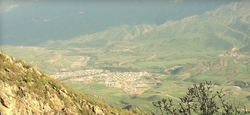Deraluk (Arabic: ديرلوك,[2] Kurdish: دێرەلووک, romanized: Dêrelûk,[3] Syriac: Deira d-Luqa)[4] is a town and subdistrict in Dohuk Governorate in Kurdistan Region, Iraq. It is located on the Great Zab and in the district of Amadiya.
Deraluk | |
|---|---|
Town | |
 | |
| Coordinates: 37°03′22″N 43°39′07″E / 37.05598°N 43.65188°E | |
| Country | |
| Region | |
| Governorate | Dohuk Governorate |
| District | Amadiya District |
| Sub-district | Deraluk |
| Population (2014)[1] | |
| • Urban | 44,448 |
| • Rural | 7,070 |
In the town, there are churches of Mar Khnana and Mar Gewargis.[5][4]
Etymology
editThe name of the town is derived from "deira" ("monastery/church" in Syriac) and "Luqa" ("Luke" in Syriac), and thus Deraluk translates to "monastery or church of Saint Luke".[4]
History
editIn 1920, Deraluk was settled by Assyrians of the Baz clan after their expulsion from the region of Hakkari in Turkey.[4] It was named after a ruined monastery of Saint Luke in the vicinity.[4] Prior to the Simele massacre in 1933, Deraluk was inhabited by 130 Assyrians, many of whom were forced to flee the violence and settled along the River Khabur in Syria.[4]
Deraluk was made a mujamma (collective town) by the Iraqi government in 1978 and settled by displaced Assyrians from Nerwa Rekan along the Iraq–Turkey border.[4] Fortry-five houses were constructed for the thirty households that came from Qārō, five households from Lower Nerwa, five households from Derigni, and five households from Wela.[4] In the following year, a church of Mar Khnana was constructed.[4]
It was used as a mujamma again in 1987–1988 during the Anfal campaign.[6] At Deraluk, Kurdistan Democratic Party guerrillas seized documents pertaining to the use of biological and chemical weapons by the Iraqi Armed Forces during the Iran-Iraq War in January 1988.[7]
On 5 December 2011, amidst the 2011 Duhok riots, alcohol shops were targeted by rioters and four were set alight and two others were ransacked.[8] In 2012, an estimated 525 Assyrians inhabited Deraluk.[9] Humanitarian aid was delivered to 72 displaced families from Mosul and the Nineveh Plains by the Assyrian Aid Society in January 2015.[10] As of 2021, 120 Assyrians with 45 families, all of whom are adherents of the Assyrian Church of the East, reside at Deraluk.[11]
Gallery
editReferences
edit- ^ Ali Sindi; Ramanathan Balakrishnan; Gerard Waite (July 2018). "Kurdistan Region of Iraq: Demographic Survey" (PDF). ReliefWeb. International Organization for Migration. Retrieved 5 September 2021.
- ^ "العراق.. محافظ دهوك يجدد مطالبته بإنهاء وجود إرهابيي "بي كا كا"". Anadolu Agency (in Arabic). 13 April 2021. Retrieved 31 July 2021.
- ^ "بەهۆی بۆردوومانەکەی تورکیا لە دێرەلووک چوار کەس گیانیان لەدەستداوە". Rudaw Media Network (in Kurdish). 24 January 2019. Retrieved 31 July 2021.
- ^ a b c d e f g h i Donabed (2015), p. 318.
- ^ "Mar Gewargiz church – Deraluk". Ishtar TV. 7 October 2011. Retrieved 31 July 2021.
- ^ Donabed (2015), pp. 204, 318.
- ^ Hiro (1991), p. 282.
- ^ Zewki, Hikmat (5 December 2011). "More liquor stores torched in Duhok, Iraqi Kurdistan". Ekurd.net. Retrieved 31 July 2021.
- ^ "Christian Communities in the Kurdistan Region". Iraqi Kurdistan Christianity Project. 2012. Archived from the original on 24 November 2020. Retrieved 14 August 2021.
- ^ "AAS-Iraq Continues The Distribution Of Clothes To Displaced Families In Deraluk". Assyrian Aid Society. 3 January 2015. Retrieved 31 July 2021.
- ^ "Population Project". Shlama Foundation. Retrieved 19 August 2021.
Bibliography
edit- Donabed, Sargon George (2015). Reforging a Forgotten History: Iraq and the Assyrians in the Twentieth Century. Edinburgh University Press.
- Hiro, Dilip (1991). The Longest War: The Iran-Iraq Military Conflict. Psychology Press.

